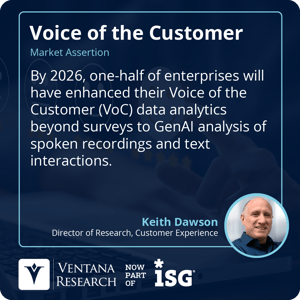Contact centers have collected customer feedback almost as long as there have been telephones. The simple binary question "Did I provide you with good service today," or some variation is a common feature of agent scripts that contact center leadership uses to produce snap assessments of agent performance. Today’s analytic approaches are becoming more common, producing more insightful and nuanced pictures of what customers want, raising the question of whether enterprises understand how best to use what is learned.
Information about customer opinions exists on a continuum. On one end is the most simplistic and easy to gather–that direct binary thumbs up or down. On the other end are inferences from advanced analysis: individual and group sentiment and intent. In the middle, you find the output of surveys and metrics like customer satisfaction, net promoter scores and loyalty scores. All of these efforts to understand customers have value to different teams in different ways. Enterprises now have information from across that continuum feeding into multiple customer experience-related teams, affecting processes that intersect with customers' journeys at many points.
The landscape for collecting voice-of-the-customer information is changing because:
- Enterprises can look at customer feedback through the lens of the results of a specific interaction or from the point of view of the overall relationship. They are related, but the former has more value to contact center operations, with the latter more impactful to the business's overall success.
- Enterprises can now work with inferences delivered by automated tools in addition to direct feedback from customers. This is part of today’s agent tool kit–for example, seeing sentiment expressed graphically by color as a call progresses. Inference also drives automated scoring of customer propensity to buy or overall satisfaction and loyalty.
- The limitations of old-style surveys and pop questions are clearer. They have often been used to validate existing assumptions about service delivery rather than draw a larger picture of the true breadth of the customer environment.
These shifts highlight one of the problems enterprises have when exploring VoC tools and issues. There is a big difference between taking in basic feedback and managing a full-fledged voice of the customer program. The tools have advanced enough to make VoC programs possible and worthwhile, but the culture around contact centers hasn't moved to take advantage of programs that formalize deep analysis of customer trends. Centers still focus on the individual and the interaction, not the life cycle. Other teams, notably product development and marketing, appear to have a bigger appetite for feedback information that sheds light on journeys, intent and behavior.
VoC efforts–the data and formal programs–are critical to shaping a business's customer experience strategy. Today’s VoC measurements are more than just reporting what people think and say; they are an analysis of the outcomes of those feelings in real terms. For example, VoC efforts can correlate sentiment with how much a person might spend or discern whether problems in customer satisfaction stem from product defects, shipping delays, agent performance or external (uncontrollable) factors. Voice of the customer data informs CX strategies so CX planning can identify turning points in the customer journey that demand greater attention and listening, where emotions or intents shift or can be shifted.
A whole-organization approach to the relationship is what allows an organization to have enough visibility into the customer to identify–or create–moments of influence or leverage. Only a cross-departmental data-gathering strategy can measure the impact of those acts and ensure growth in the relationship and customer value.
The introduction of generative AI into contact center platforms has been a catalyst for more expansive uses of customer feedback. AI allows for analysis of a great deal more raw input than in the past and to look at it from different points of view. AI makes visible the interactions that bypass the contact center, unearthing insights inside data sources that go unused, especially unstructured sources like voice recordings. What people say directly in a text communication may be at odds with what is inferred from the sound of their voice or the context of the interaction. GenAI identifies patterns and trends that encourage businesses to anticipate future customer needs or issues and respond proactively. This also encourages connections between those in the enterprise who view CX strategically (marketers, sales teams) and those on the front lines who directly interact with customers individually.
Enterprises are also now more reliant on recurring or subscription-based revenue in business-to-business and business-to-consumer contexts. In those cases, there are more frequent interaction points (including passive ones, like automated billing) that can produce useful data and a greater need for feedback and insights to maintain an ongoing relationship.
Given the changes in technology and the gap between how contact centers and the rest of the enterprise manage feedback information, buyers should be looking at the broadest possible toolset for collecting and analyzing customer voices. At a bare minimum, a current VoC tool should collect feedback across the range of contact channels: voice, chat, email and even social media. It should also provide an easy integration to whatever customer data resources the organization uses, whether customer relationship management or customer data platform. We assert that by 2026, one-half of enterprises will enhance VoC data analytics beyond surveys to generative AI analysis of spoken recordings and text interactions.
possible toolset for collecting and analyzing customer voices. At a bare minimum, a current VoC tool should collect feedback across the range of contact channels: voice, chat, email and even social media. It should also provide an easy integration to whatever customer data resources the organization uses, whether customer relationship management or customer data platform. We assert that by 2026, one-half of enterprises will enhance VoC data analytics beyond surveys to generative AI analysis of spoken recordings and text interactions.
Beyond those basics, the most important element to consider is whether the system can infer customer sentiment that is related to specific interactions and the overall relationship. Breadth of information tells you more about a customer's intent than narrow questions on surveys. CX professionals should look at "intent" as a proxy for long-term value. Buyers should also ask whether they can use analyzed feedback, both direct and inferred, in real time during interaction to manage towards a desired outcome.
Software providers are starting to edge away from the term "voice of the customer" in describing the latest iterations of the technology. This may be because customer feedback is now much more than the voice component, incorporating non-verbal and inferred content. The specific tools or features related to collecting VoC are embedded in other applications and platforms, including customer data systems, AI platforms, agent desktops and elsewhere. Buyers can either build a VoC program from the existing pieces they likely already have access to in their cloud platform or other contact center system, or use a dedicated point solution built for the task. That decision should be based more on the internal business imperatives than on a perceived difference in the quality of either deployment approach. It does suggest, though, that suite vendors can be more vocal about how the pieces within solutions connect into a VoC/feedback system.
Customer feedback data is a good place to start breaking down organizational silos. Buyers should look for the ability to integrate into multiple back-office analytic systems. Systems should support multiple data sources, and AI should, by this point, be table stakes in any request for proposal. Since VoC tools can be purchased either stand-alone or as part of a suite, buyers should explore how AI and analytics are threaded through each vendor’s platform and how VoC data is handled. Whichever deployment mode a business chooses, it should recognize that continuous customer feedback is essential to using CX as a strategy for growth, revenue and satisfaction. You can't influence what you don't measure.
Regards,
Keith Dawson

 possible toolset for collecting and analyzing customer voices. At a bare minimum, a current VoC tool should collect feedback across the range of contact channels: voice, chat, email and even social media. It should also provide an easy integration to whatever customer data resources the organization uses, whether customer relationship management or customer data platform.
possible toolset for collecting and analyzing customer voices. At a bare minimum, a current VoC tool should collect feedback across the range of contact channels: voice, chat, email and even social media. It should also provide an easy integration to whatever customer data resources the organization uses, whether customer relationship management or customer data platform. 








